Text
Web 3, The Good News and Bad News
Original published in The Seville Report Newsletter, March 2022 Edition.

Another day, another dollar, and another new thing to investigate, interrogate, dissect, put back together, and then monitor with suspicion. The new thing this time is Web 3.0 or Web3. The terms have been quickly making their way through Wall Street and Main Street. There are promises of riches, and a newer, better internet, from the people that have jumped on the Web 3 bandwagon early. There have also been warnings from people who see Web 3 as a hoax and marketing ploy.
While researching the metaverse, we’ve been able to gain insight into Web3. We’ve read the good, we’ve read the bad, we’ve read the promises of fortune, and the cautionary tales of financial disaster. Experience has shown that there are few things that are all good or all bad, and that the truth of the matter usually lies somewhere in the middle.
What is Web 3?
Web3 or Web 3.0 is a term used to describe the next iteration of the internet. The internet we are accessing now is Web 2.0, and it was a big change from Web 1.0.

During the early days of the internet, or Web 1.0, webpages were static. There were links to other pages, and very pixelated images, but little else. Web 1.0 is often referred to as the read-only internet, because it didn’t allow for much user interaction. With Web 2.0, websites became dynamic, the information on a website could change from minute-to-minute. Websites became more interactive, users could read something on a website and also write something on the site, like a review or an opinion. Websites were able to host more types of media, and display crisper images. Web 2.0 also allowed for social media and mobile apps. For anyone who lived through Web 1.0, the move to Web 2.0 was like the greatest thing since sliced bread.
Now, Web3 promises to be a more decentralized version of Web 2.0, but written on the blockchain. The parts of Web 2.0 that we utilize will move to the blockchain, things like social media and search. On the blockchain, users will be able to control and monetize their own data. At least that’s the promise.
New Tech, New Money
The good news for investors is that there is money to be made in the move to Web3, like there always is when new technology emerges. Coincidently, we’ve recently experienced this with blockchain technology. Over the last 10 years Bitcoin has exploded from under $20 per digital coin to over $60,000 a coin. An investment in Bitcoin was and still is an investment in blockchain technology, and that investment has paid off big for its early investors. In another example, Apple’s stock price is up ~3,920% since the first iPhone release. The introduction and adoption of the smartphone by the masses, rewarded Apple investors generously. Netflix started streaming content in late 2007, and its stock price has increased by more than 11,000% since that time, rewarding investors who took an early leap of faith on digital content creation and curation.
The good news for investors is, those prophesying about Web3 riches aren’t lunatics. It is likely that the move to Web3 will copy the move from Web 1.0 to Web 2.0 and bring great investment opportunities.
There Will Be No Utopia
One of the major talking points about Web3 is that it is going to be decentralized. There is a vision amongst Web3 disciples that the new version of the internet will transfer power from big tech firms and give it to the user. Unfortunately, this is where the bad news comes in.
The internet as we know it is decentralized. An early version of what would become the internet was created to decentralize U.S. communications during the Cold War. The internet being centralized has never been the problem, the issue has been that people like to centralize.
Statista reports that 71% of U.S. internet users visit Facebook regularly. Similar Web estimates that Instagram had 6.8 billion total visits in December 2021, ranking IG as the 4th most visited site globally. Amazon Web Services , Google Cloud, Meta, and Microsoft Azure control an ample mass of the data that occupies the websites we use day-to-day. Between the four companies, it’s estimated they hold 1,200 petabytes of data. To get an idea of how massive that is, one 4K movie takes up 100 gigabytes, 1 petabyte can hold 11,000 4K movies.
For Web3 enthusiasts, the hope is that by moving the internet to the blockchain, companies like Google, Facebook, Apple, and Amazon will lose the grip they’ve had on internet users on Web 2.0. The irony is that big tech companies are putting billions of dollars into Web 3.
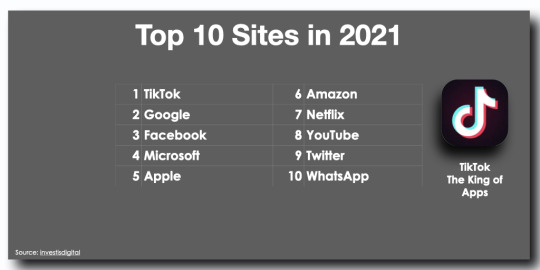
In Fall of last year, Facebook CEO Mark Zuckerberg announced to the world that the company would change its name from Facebook to Meta to reflect its focus on the metaverse. The metaverse and Web 3 are closely related, if Web 3 is the highway, the metaverse is the car. In Meta’s Q4 2021 earnings, the company reported a $10 billion loss from its metaverse division. Andreessen Horowitz, the venture capitalist firm that made winning early stage bets on companies like Meta, Twitter, Coinbase, and Skype announced it would raise $3.5 billion to invest in crypto funds and an additional $1 billion to invest in Web3 seed investments. What Meta has invested, and what Andreessen Horowitz is getting ready to invest, indicates that the entities that won and are winning on Web 2.0 are investing to keep the winning streak going on Web 3.0. Mark Zuckerberg isn’t losing $10 billion a year so that he can give me or you control.
The Promise
From what we’ve gathered, the move to Web3 will provide amazing investment opportunities. The blockchain has been recognized as a very powerful technological invention, even by people that aren’t entirely sold on Bitcoin, it makes sense that it would be the place to house the next version of the internet. However, it likely won’t be the utopia some people hope.
Web 3 is a Battleground
Web 1.0 was dominated by Netscape, America Online, Yahoo, and Microsoft in the mid to late 90s. Web 2.0 has been monopolized by the FAANG companies, Facebook, Amazon, Apple, Netflix, and Google. Microsoft was able to correct course in the mid 2010s to enjoy some Web 2.0 success, but AOL and Yahoo have been unable to reclaim their glory days. Web3 is a battleground, and similar to real war, securing positions is paramount to success.
When I see the internet, I see it as a box, and in my head, Google controls roughly 60-70% of the box, Facebook has a big corner of the box as does Amazon, but it’s mainly Google’s box. Web3 at the moment is another box, but it’s fairly empty. Companies like Meta, Andreessen Horowitz, Nvidia, Block, Unity Software and others are investing big in hopes of securing a large piece of the Web3 box, because it has serious implications.
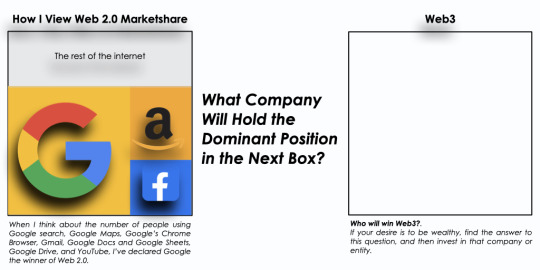
My belief is that successful Web3 investing will happen by investing in the people or companies that can centralize users on the new internet. This is contrary to what Web3 evangelist have preached to date, but the truth is, we the people want to control of our data, but we don’t want to be alone physically or virtually.
#metaverse#web3#web3.0#web2#blockchain#Google#Apple#Amazon#Facebook#Meta#Netflix#Microsoft#Yahoo#Netscape#AOL#money#investing#Investments#InvestmentEducation#FinancialEducation
0 notes
Text
After Batgirl, Is House of the Dragon Safe?
Warner Bros. Discovery's decision to cancel the production of Batgirl mid production shocked comic book fans and Wall Street investors.
With WarnerMedia in the hands of new owners, cutting expenses has become the priority.
At nearly $20 million an episode, can House of the Dragon survive a slow start under Warner Bros. Discovery?

Read Full Article: https://bit.ly/3bFkNI7
Why was the Batgirl movie canceled? The answer to that question is AT&T ($T), and their grand, but bad plan. What was AT&T’s plan?

Read Full Article: https://bit.ly/3bFkNI7
Movie Economics
Movie economics requires a film to bring in three times the advertised budget in order for the film to make a profit for the studio. This means that Batgirl - which had already hit $90 million in production costs - would have needed to make $270 million for the film to make a profit, and that’s if $90 million was the final number needed to finish the film. In the current state of live action comic book consumption, $270 million doesn’t seem like a tough number to get to.

Read Full Article: https://bit.ly/3bFkNI7
But What About House of the Dragon
The surprise from the Batgirl news leads me to wonder, what will House of the Dragon be like? Whose vision will the show be made in? And how long will it stick around? In HBO’s heyday, when the network was producing top tier content like The Wire, The Sopranos, Sex in The City, Rome, True Blood, Boardwalk Empire, and Game of Thrones, Richard Plepler was the head of HBO. Plepler left HBO after Time Warner was acquired by AT&T. All guesses point to Plepler not wanting to be a part of the make HBO into Netflix experiment.

Read Full Article: https://bit.ly/3bFkNI7
It’s very rare to have comic book fans and Wall Street focused on the same thing at the same time, but last week’s news did just that. The move by Warner Bros Discovery to scrap the Batgirl film after investing $90 million had comic book fans and Wall Street asking, WTF? But the issue at hand was created by AT&T, who had no clue how to run a media company, when they purchased a media company to make a streaming service. AT&T made a big mess of the Warner Bros assets, and now the team at Warner Bros Discovery has been tasked with cleaning up that mess.
What’s the Outlook for Warner Bros. Discovery stock?
Read Full Article: https://bit.ly/3bFkNI7
#warner bros discovery#HBO#HBOMax#ATT#Investing#Investments#Streaming#StreamingWars#InvestmentEducation#FinancialEducation#Money#TikTok#Netflix#DisneyPlus#ContentCreation#Batgirl#HouseOfTheDragon#GameOfThrones#TheWire#TheSopranos
2 notes
·
View notes
Text
Ford’s Time to Shine
Ford achieved huge earnings and revenue growth in Q2 2022, showing that the company is gaining momentum from its electric vehicle initiative.
The good mood around Ford's Q2 results changed after a report mentioned the company would layoff 8,000 workers.
Ford has seen great demand for its two private passenger all electric offerings, causing the company to increase production to meet demand.
With the average cost of EVs hitting $60,000, Ford has an opportunity to gain EV market share by producing attractive and affordable EVs.

Full article: https://bit.ly/3BxjJAI
This is Ford’s Time
After a Q2 earnings call where Ford ($F) announced that the company increased earnings by 385% year-over-year during the quarter, and revenue by over 50% year-over-year, the big Mo (momentum) is on Ford’s side. But, rumors of the company laying off 8,000 of its employees has dampened the celebration from the earnings call.

Full article: https://bit.ly/3BxjJAI
Why it’s Ford’s Time
The five years before covid were tough times for Ford investors. The stock opened 2015 trading at $15.59 per share, and by February 2020, right before the market sell off sparked by COVID-19, the stock traded for $9.18 a share. During that same five year span, the S&P 500 gained 62%. But in 2021 things started to change for Ford and its stock price. The company revealed its fully electric Mustang Mach-E, a direct competitor to Tesla’s Model X ($TSLA).
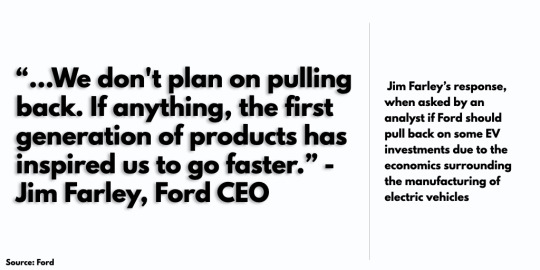
Full article: https://bit.ly/3BxjJAI
Ford’s Q2 2022 earnings conveyed to Wall Street and retail investors that the company isn’t squandering the momentum it gained from last year. And the layoffs are a sign that the company is shifting its priorities, which is another good sign for investors.

Full article: https://bit.ly/3BxjJAI
2022 and Beyond
With momentum on its side from the Q2 2022 earnings reports, and a management team ready to embrace electric vehicles, Ford has the opportunity to reshape how customers and investors view the company. The next five years for Ford, and the Ford e division, could be better than the company’s last 20 years.
#Ford#ford f-series#F150Lightning#mustang mach-e#Mustang#electricvehicles#EVs#Tesla#Rivian#StockMarket#Stocks#Investing#Investments#InvestmentEducation#FinancialEducation#Money#StockInvesting#WallStreet#auto industry#F150#GeneralMotors
0 notes
Text
Fintech Stock to Watch if We’ve Already Hit Market Low
A revenue miss in 2021 started the sell off in PayPal.
A rumor of an acquisition the market deemed not a good fit accelerated the selling of PayPal's stock.
Now 77% below its all-time high, PayPal's weakness may be a great buying opportunity.

Full article: https://bit.ly/3NTIVnz
Story
Before FinTech became a Wall Street buzzword, and before Buy-Now-Pay-Later became a big thing, this financial tech company was quietly providing investors with solid gains. In 2016 the stock price increased 15%, in 2017 the stock increased 84%, and 10.9% in 2018. And in 2019 the stock price increased nearly 33%. 2020 came, and along with it came the coronavirus. Like most stocks, this stock decreased in late February 2020, bottomed out in March, and then went on an incredible bull run. From the March 2020 bottom ($82.07) to its July 2021 all-time high of ($310.16) the stock returned 277%, more than doubling the S&P500’s return (101%) over the same timespan.
Full article: https://bit.ly/3NTIVnz
#Technology#FinTech#Financial#WallStreet#Investing#Investors#Investments#FinancialEducation#InvestmentEducation#MoneyEducation#BNPL#BuyNowPayLater#MarketDecline#Recession#BearMarket#Nasdaq#Stocks
0 notes
Text
Amazon Makes Another Attempt At Healthcare
Amazon spends $3.9 billion to acquire medical provider One Medical.
The acquisition marks Amazon's latest attempt to enter the healthcare industry.
What One Medical does that appeals to Amazon.

Link to full article: https://bit.ly/3cIq1De
A Can't Miss Collaboration
In 2018, Jeff Bezos, Warren Buffett, and Jamie Dimon joined forces to tackle the American healthcare system. The announcement of the project, called Haven, got the fanfare it deserved at the time. Jeff Bezos, Amazon’s ($AMZN) founder and CEO and the king of technology-retail, Warren Buffett, the CEO of Berkshire Hathaway ($BRK-A) and long time investor who had extracted billions of dollars from the stock market, and Jamie Dimon, the CEO of JP Morgan Chase ($JPM), one of the world’s largest financial institutions, were joining forces to benefit us all.
Bezos, Buffet, and Dimon were seen as a can’t miss team, but they did.
Last week Amazon announced its acquisition of One Medical ($ONEM) for $3.9 billion. One Medical operates a national chain of primary care clinics, and it represents Amazon’s latest push into healthcare.
Link to full article: https://bit.ly/3cIq1De
What Makes One Medical Appealing to Amazon?
There’s a lot to like about One Medical from Amazon’s point of view. The company has over 700,000 consumers, 8500 enterprise clients, and over 180 medical offices in 25 markets. It also has a subscription service that grants patients a certain number of telehealth visits and in-person visits for a yearly fee. But if I had to take a guess, it would be that One Medical’s technology, its data, and its price are what appealed to Amazon.

Link to full article: https://bit.ly/3cIq1De
Healthcare, the Next Frontier
Healthcare is an industry that could provide tech companies like Amazon a long runway for growth, if they can successfully break in. CMS reported that U.S. healthcare spending reached $3.81 trillion in 2019, and was expected to grow at an annual rate of 5.4%. And Amazon isn’t the only tech company that’s trying to break in. Early last week Apple released a report which detailed how Apple’s technology can be used to support personal health, research, and care.
#Amazon#Healthcare#Medical#USHealthcare#MedicalCare#Medicaid#Medicare#Investing#Investments#InvestmentEducation#InvestingEducation#FinancialEducation#Money#Stocks#WallStreet#Stockmarket#OneMedical#MedTech#Technology
0 notes
Text
The Issue With Gap
Gap's lack of identity has cost another CEO their job.
Gap's stock price has declined 67% since 2019, and has forced CEO Sonia Syngal to resign.
Syngal's resignation signals to the market that the Gap and Kanye West collaboration wasn't enough to turn the company around.
There are several solutions Gap's management could employ to turn the company around.

Link to Full Article: https://bit.ly/3ILuz7N
What’s Wrong With Gap?
Gap Inc. is more than just the Gap. The brand encompasses The Gap, Old Navy, Banana Republic, Intermix, Janie and Jack, and Athleta. I know what Old Navy represents, and I know what Banana Republic represents, but what is the Gap? This is something I believe that Gap’s management doesn’t know the answer to, and this is what’s wrong with Gap Inc.
Link to Full Article: https://bit.ly/3ILuz7N
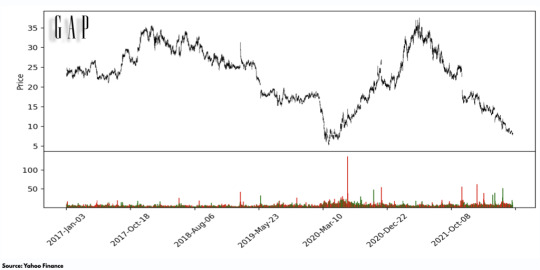
Enter Kanye West
In June 2020 Gap partnered with rapper, producer, and fashion designer Kanye West. The move was supposed to reinvigorate the company and bring shoppers back to Gap, instead it cost the company another CEO. Earlier this week Gap CEO Sonia Syngal announced that she would be stepping down. Gap’s stock opened the following day down 6.5%.
Link to Full Article: https://bit.ly/3ILuz7N

It’s Not Amazon, It’s a Lack of Vision
In 2020, Wells Fargo and Morgan Stanley estimated that Amazon ($AMZN) did $30 billion in apparel sales, making it the nation's leading apparel retailer. During the same year, Target ($TGT) attributed $14.7 billion of its $92.4 billion in sales to apparel and accessories according to the company’s annual report, and Walmart ($WMT) generated $5.48 billion from home and apparel sales according to businessquant.com. Amazon has been the quick and easy response to why brick-and-mortar retailers are dying, but it has more to do with what Amazon did 20 years ago, and not what they did five years ago.
Link to Full Article: https://bit.ly/3ILuz7N

Another reason for Gap’s struggles is the company has been very bad at capitalizing on the shifts in apparel trends. In 2008 Gap acquired Athleta, a store that sells athletic and athleisure wear for girls and women. Though the athleisure wear movement hadn’t fully taken off yet in 2008, Gap Inc. had positioned themselves to take full advantage of it, but they didn’t. Instead, Lululemon became the name synonymous with women’s athleisure wear, not Athleta. Between 2010 and 2020, Lululemon’s stock increased 1400% and Gap’s stock lost 15.8%. Gap also fumbled their mens athleisure wear brand Rock Hill, which launched in 2018 and closed in 2020.
Link to Full Article: https://bit.ly/3ILuz7N

The One of the Solutions
Gap’s new CEO should focus on establishing an identity for the Gap brand. I believe as Gap goes, so does Gap Inc. Currently, the identity is, “we sell clothes” which isn’t a good identity at all. Consumers can buy clothes from anywhere, the Gap needs to explain to consumers what type of clothes they should go to the Gap to buy. Whether it be clothes to work in, clothes to wear during a night out, clothes to Netflix and chill in, clothes to skateboard in, clothes to hike in, clothes to go to school in, or clothes to go to church in. Redo the company’s Instagram page, get rid of the models in Gap clothing against white and black backgrounds. Put people in Gap clothing doing things that people do. Use social media to show consumers where Gap clothing will work for them. Without an identity for the Gap brand, Gap Inc. is a lost cause, and a bad investment.
Link to Full Article: https://bit.ly/3ILuz7N
#Apparel#Fashion#StreetFashion#FastFashion#Gap#GapInc#BananaRepublic#OldNavy#Athleta#Lululemon#Nike#Polo#RalphLauren#TommyHilfiger#Adidas#KanyeWest#Yeezy#SoniaSyngal#Yeezys#Walmart#Target#Amazon#FashionTrends
0 notes
Text
Social Media Stock To Watch, If Market Sell Off is Over
SNAP's stock is 80% below its all-time high following an earnings miss and an adjustment to its revenue forecast.
Apple's iPhone update that prevents companies from tracking iPhone users without the user's consent had a negative impact on SNAP, but the company may have found a workaround.
Gen Z's connection to Snapchat as well as Snapchat's work with augmented reality are two of several reasons that SNAP's stock price could bounce back in a big way.

Read Full Article: https://bit.ly/3ytMUkW
Story
On December 20, 2018 SNAP’s ($SNAP) stock traded below $5.00 a share. SNAP, the parent company of social media app Snapchat, had been a publicly traded company for 21 months up to that point. In those first 21 months, SNAP’s stock spent 17 months trading below its IPO price. As a public company, things weren’t going well for SNAP and its leadership.
But December 2018 would mark the low for SNAP. Later on, the company would release its baby face filter, which became extremely popular across social media and television, and the stock price would rebound.
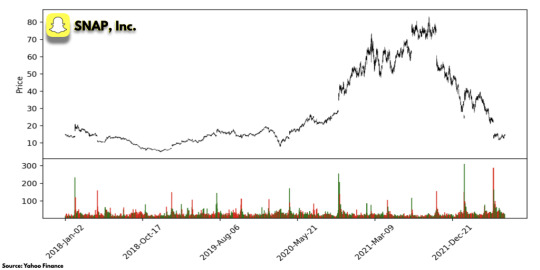
Where it Started to Fall Apart
October 21, 2021, SNAP reported $1.07 billion in revenue during the third quarter of 2021, a 57% year-over-year increase in revenue, but $30 million below analyst’s estimates and below the low-end of the company’s own revenue guidance. The reason behind the revenue miss was Apple. Apple's upgraded software to its iPhone line, prevented digital advertisers from tracking users without their consent. SNAP’s stock price would fall 23% after the earnings release.
Read Full Article: https://bit.ly/3ytMUkW

What Could Spark Its Recovery
Before the announcement in May that alerted investors to the company’s struggles in the current economic environment, SNAP’s stock was trading close to $23.00 per share. Now trading at just under $15 per share, the stock could see an increase if the company is able to meet the low expectations the market has for it. Analysts have revised their full year earnings per share expectations for SNAP down from $0.50 cents a share to $.22 per share. If June 22, 2022 was the market low, and the stock market and global business activity stabilizes over the next five months, Snap could meet and possibly exceed analyst's estimates.
Read Full Article: https://bit.ly/3ytMUkW
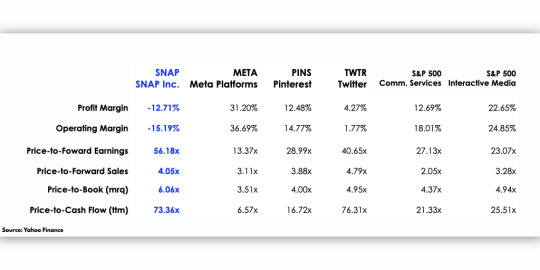
Snap also has youth on its side. Over the last year, Meta’s failure to attract younger users to its platform has been well documented, but that’s not a problem for SNAP. According to Sprouts Social, 48% of Snapchat users are between 15 and 25 years old. Snapchat has been the social media platform of choice for Gen Z (people born between 1997 and 2012). A Wunderman Thompson report puts Gen Z spending at almost $100 billion, and that doesn’t include the impact that the younger Gen Z members have on their parent’s spending. In comparison, Millennial spending is only $65 billion. If brands want to get their products and services in front of Gen Z, Snapchat is one of the best places to do it.
Read Full Article: https://bit.ly/3ytMUkW

#snapchat#SNAP#SnapAR#Augmented reality#advertising#Ads#Advertisers#SocialMedia#metaverse#Twitter#MetaPlatforms#Pinterest#TikTok#Money#stocks#StockMarket#wallstreet#InvestmentEducation#InvestingEducation#StocksToWatch#GenZ#GenZ Things#BuyingPower#gen z vs millenials
0 notes
Text
Meta as a company is floundering and no longer the industry titan it once was.
Meta's stock returns over the past five years have lagged other tech giants and the S&P 500.
The company's lack of innovation and attempts to capture a piece of every fad should concern investors.
We foresee Meta losing its position to another social media company that prioritizes what Meta will not.
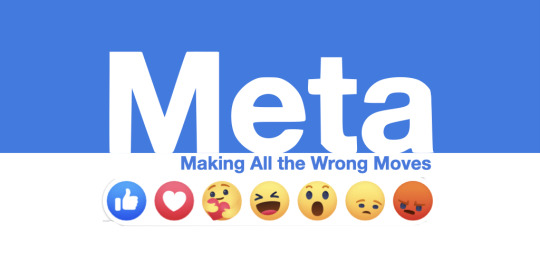
Link to full article: https://bit.ly/3a0LDcG
This is the story of Facebook, now known as Meta. It’s transformed from a platform where we could stay connected with friends and family, to a mess that is force feeding us content that we don’t care for. Facebook is a dead company walking. Investors beware.
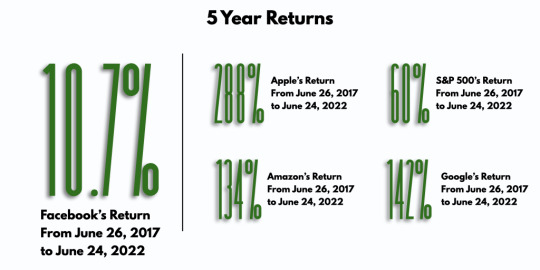
Link to full article: https://bit.ly/3a0LDcG
Facebook’s largest demographic is aging, but they're not dead, nor are they at the point where they’re entering a nursing home. A 34 year old still has 30 to 40 years of work ahead of them. They have big vacations ahead, as well as their children's education, home purchases, car purchases, and so many other things that they could be given the motivation to buy with the right advertising.

#Facebook#Meta#MetaPlatforms#Metaverse#Investing#Investments#InvestmentEducation#FinancialEducation#Investing101#Stocks#Stockmarket#WallStreet#SocialMedia#TikTok#ForYouPage
0 notes
Text
Get Rich or Go Broke Trying
The wild investment strategies found on social media are causing people to take extraordinary risks.
Financial stability from working hard isn't happening, pushing people towards risky investment ideas.
Without guidance from knowledgeable people who have created wealth, young adults seeking to create wealth for themselves are acting on shaky investment advice in hopes of big gains.

Link to Full Article: https://bit.ly/3QtkxeO

A few weeks ago I came across the hilarious twitter account @TikTokInvestors. The feed is a collection of people young and old giving some questionable investment advice. The specific tweet that led me to the account was a video of a person planning to buy a $1.4 million home by putting down $290,000 on the home, and putting $450,000 into a DeFi protocol...
Link to Full Article: https://bit.ly/3QtkxeO

When Working Hard is Getting You No Where
We all want the same thing. We're all looking for some form of success. We all want to find something that allows us to maximize our abilities. We all want to make a good, if not a great living. We want good health for ourselves and our families. We want our kids to have better opportunities than we did. And we want safety and security...
Link to Full Article: https://bit.ly/3QtkxeO
#Investments#InvestmentEducation#FinancialEducation#Money#StockMarket#TikTokInvestingAdvice#TikTokInvestments#Stocks#Crypto#DeFi#GameStop#AMC#Reddit#twitter#Facebook
0 notes
Text
I Regret to Inform You, This is the Apple Car
The Apple Car rumors are back after Apple's most recent developer conference.
Based on Apple's history, the Apple Car seems unlikely, but it will be a major player in the automotive industry.
Where I think Apple will make its move into the auto industry, and why it's better than manufacturing a car.
After Apple’s Worldwide Developer Conference, where Apple ($AAPL) showed off updates to its CarPlay service, investors and others are hoping that the demonstration Apple gave is a peak into the beginning of the Apple Car. I regret to inform you that what we saw is the Apple Car.
Link to full article: https://bit.ly/3MEs4El

Is this what you think of when you picture the Apple Car?

A look into Tesla’s capital expenditure-to-revenue, and you can see it’s expensive to get a new car company off the ground. Ford and GM have been in the car business for over 100 years, so they’re capital expenditure-to-revenue is much lower than Tesla’s. Is Apple willing to up their capital expenditure to establish the infrastructure needed to build and sell cars at scale?
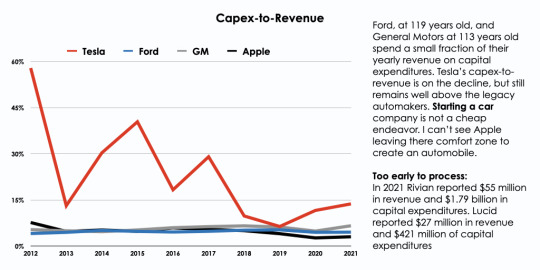
Who’s Missing?

Car companies that are build with tech in their DNA are missing, companies like Tesla, Rivian, Lucid, Fisker. Apple’s move into automobiles will help the auto manufacturers that aren’t technology companies add an element of technology to their offerings.
Link to full article: https://bit.ly/3MEs4El
#AppleCar#AppleStock#Apple#Tech#WWDC2022#CarPlay#Money#Investing#InvestmentEducation#FinancialEducation#StockMarket#WallStreet#ValueInvesting#autonomous vehicles#Auto Industry#Electric Vehicles#EVs
0 notes
Text
The Tech Reset, it's a Good Thing
The NASDAQ closed down for the seventh straight week.
The fall in technology stocks is reminding investors of the dot-com bubble burst.
The fall in tech is a good thing and will allow investors to reconsider how they value tech companies in the future.
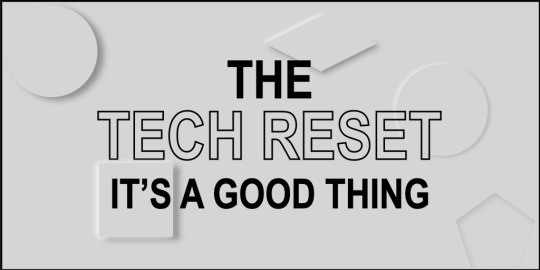
The Nasdaq closed down for the seventh straight week, recording its longest losing streak since 2001. For anyone who isn't sure, a reset in tech is underway.
Two weeks ago, David Sacks, a co-founder of PayPal ($PYPL) and a general partner of Craft Ventures stated that the current tech environment is the worst he’s seen since the dot-com crash. This coming from someone who survived the dot-com bubble burst.
The decline in the NASDAQ might be painful, but it's necessary. It's time to separate the real from the fluff.
To read the full article: https://bit.ly/3lABp5g
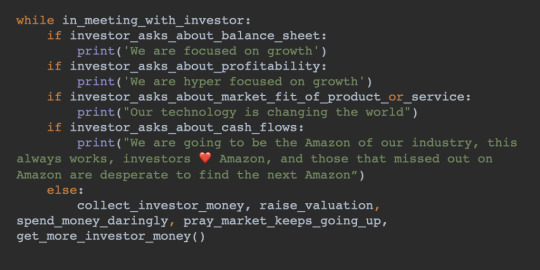
#stocks#investments#Investing#StockMarket#BearMarket#NASDAQ#Tech#TechStocks#TechnologyStocks#Technology#silicon valley#Tech Layoffs#dotcom bubble#Apple#Amazon#PayPal#Adobe#InvestmentEducation#FinancialEducation#MoneyEducation
1 note
·
View note
Text
Boom-Bust-Boom: A Bitcoin Saga
Bitcoin is down more than 50% from its November high.
Bitcoin's past indicates that it could drop even further.
In the past, Bitcoin has logged triple digit percentage gains following long periods of decline.
Can Bitcoin put together another big bull run?

Triple Digit Gains
According to Investopedia, the average annualized return since the S&P 500 adopted 500 stocks into the index in 1957 through Dec. 31, 2021, is 10.67%. The annualized return for Bitcoin from the $2.22 valley in 2011 to the 2021 close of $47,000 is 171%. The S&P 500 has provided comfortable retirements, while Bitcoin has provided early retirements with Lambos, but does it have another 500% gain in it?
Anyone who has followed or invested in Bitcoin, has learned to get comfortable with the boom-bust-boom nature of the cryptocurrency. Nothing falls as hard as Bitcoin when it comes to investments. In 2013 it dropped 80% in two days. On the other hand, few investments bounce back like Bitcoin has in its past. I took a look at five major boom-bust-boom periods from Bitcoin's past to get an idea of what could be in store for Bitcoin's future.

Source: Bitstamp/Tradingview
In August of 2011 Bitcoin hit a high of $11.85, which doesn't seem like much today. But in 2011, it was a very big deal. In its beginnings, Bitcoin traded for less than a penny, so hitting $1, and then $10 plus, was a big deal.
After hitting $11.85, Bitcoin spent the following two months in decline and would bottom out at $2.22, marking an 81% loss in value over two months. 10 months after trading down to $2.22 Bitcoin broke past the old peak, registering a 439% gain from its valley to its new high. 439% in 10 months, not bad at all
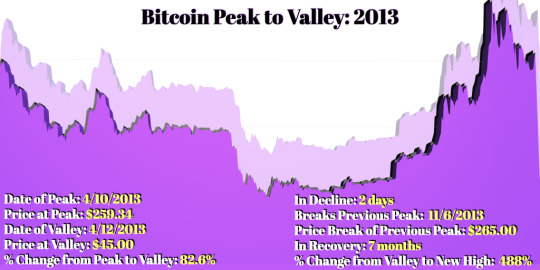
Source: Bitstamp/TradingView
In 2013 Bitcoin reached another peak of $259.34. After reaching that peak, it would drop 80% in two days and bottom out around $45.00. The cryptocurrency would take seven months to recover. From the valley to the break of the old peak, Bitcoin registered a 488% gain.

Source: Coinmarketcap.com
In December of 2013 Bitcoin would peak again. After trading to over $1,000 per coin, Bitcoin would spend the following 23 months in decline. After bottoming out at nearly $178, it would take 15 months for the cryptocurrency to recover and break past the December 2013 peak.
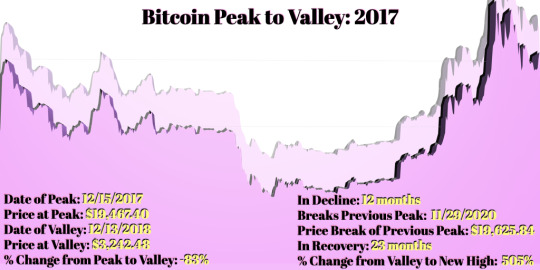
Source: Coinmarketcap.com
Bitcoin's run in 2017 stands out for a lot of reasons. It's when I noticed local news stations reporting on the state of Bitcoin. 2017 was the year that people who used hundreds of Bitcoins to buy a coffee in 2014, realized that they had consumed the most expensive cup of coffee they would ever drink. 2017 was also the year we saw a condo be sold for Bitcoin only. It was a wild year, and after peaking again 2017, Bitcoin would spend the next 12 months in decline. It took 23 months to trade from its December 2018 bottom, to the break of the old peak.
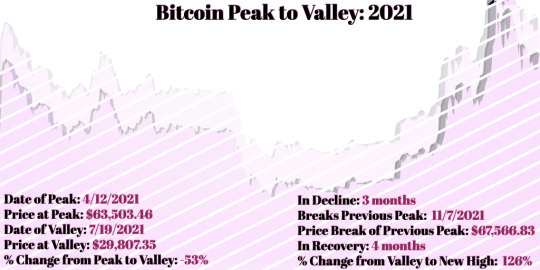
Source: Coinmarketcap.com
The beginning of 2021 greeted investors with Meme Stock Mania. From January 8, 2021 to January 21, 2021 Bitcoin experienced a slight decline, as speculators briefly left the crypto currency to invest in GameStop ($GME) and other meme stocks. As the meme stock trade started to unwind, money found its way back into Bitcoin.
It was a pleasant surprise when Bitcoin topped $63,000 in April of 2021. When it crossed above $60,000, Bitcoin enthusiasts were speculating that the coin could hit $100,000. But the good times would soon come to an end, and Bitcoin would decline over the next three months. It would bottom out at $29,807, marking a 53% loss of value from the April high. But after hitting its bottom in July 2021, Bitcoin would spend a short four months recovering from its most recent fall in price. Bitcoin would trade above its old peak in November 2021.
29,000 and Where we are Now
After peaking again in November 2021, Bitcoin has been in decline for the last six months. What I'm trying to figure out is if this is going to be a 12 month decline similar to the one that started in 2017, or a 23 month decline, like the one that started in 2013?
In reviewing a few of Bitcoin's past busts-and-booms, four times in the past Bitcoin declined 80% or more from its peak. As of this writing Bitcoin is down 56% from the $68,789 high it traded to last November. An 80% drop from those prices would bring its price to just under $14,000 a coin. At less than $14,000 are we still thinking Bitcoin is the future or are we thinking it's over for Bitcoin?
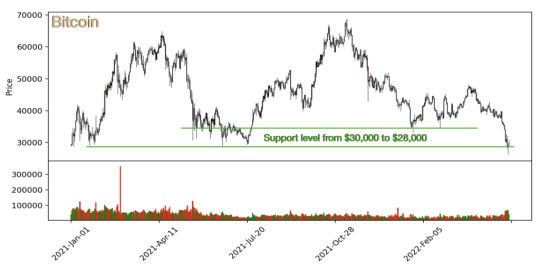
Chart Data: Yahoo Finance
Technical traders - traders who use charts to make their investment decisions - often note areas on a chart where something important happened. For instance, where an investment stopped rising in price, where an investment stopped dropping in price, the range that an investment trades in if it is range bound, and the upper and lower levels of the range. All of these areas on a chart can provide clues to what an investment will do in the future.
In the case of Bitcoin, the range between $28,000 and $30,000 is where it stopped falling, when it pulled back from its April 2021 peak. It also found support around the same price range back in January of 2021. Since this price area is where Bitcoin has stopped declining on a few occasions, traders will mark this area as an important level of support, since this is where Bitcoin's price found support in the past.
Last Thursday, when Bitcoin's price briefly fell to $26,000, it was quickly bought up by investors, and the buying caused the price of Bitcoin to trade back to $29,000. The buying that occurred on Thursday supports the theory that Bitcoin bulls had buy orders set at the support level of $30,000 and slightly below, and once the price of Bitcoin reached the support level, buy orders triggered. Since those buy orders were triggered, Bitcoin has held steady. But, if Bitcoin fails to start rising in price in the near term, investors who purchased the coin between $30,000 and $26,000 will sell their Bitcoin and reset their buy orders at another level of support. The next significant level of support would be in the range of $21,000 and $18,000, which is where Bitcoin peaked in 2017. If that area doesn't hold, then we're looking at the $13,000 range, a level Bitcoin traded to in 2019 after the 2017 collapse.
I don't consider myself to be a master stock technician or chart wizard, but I understand the basic concepts of support and resistance, and I also know that most of the time, picking a price level where a security should stop falling in price is an educated guess at best, so be warned.
What to Do?
The history of Bitcoin says do it, go in, buy some Bitcoin and be prepared to buy some at even lower levels, and in three years sell it, buy a Lambo, talk to your peers and haters like you're a crypto investing genius, and live happily ever after.
#Bitcoin#Cryptocurrency#crypto#cryptomarket#crypto news#Cryptoinvesting#investments#investing#stockmarket#ethereum#eth#meme stocks#meme coins#lamborghini#lambo#investment#InvestmentEducation#FinancialEducation#money#digitalmoney
0 notes
Text
Markets are Down, So Go Shopping
The decline in the markets have created buying opportunities in stocks.
Investors have been conditioned to avoid markets when stocks are cheap.
Over the long term buying the dip has proven to be an effective money maker for investors.

Are you scared? Then buy some stock. Are you worried about the future of the economy? Great, buy some stock. If watching CNBC makes you worry about your retirement, so what, buy some stock. Buying the dip has worked for millionaires and billionaires in the past, and it will work for you to.
Investing when asset prices are dropping, seems counterintuitive, because we’ve been wired to think in a way that’s not conducive to wealth building. When it comes to investing and investments, we’re wired to be sad when asset prices decrease, not interested when asset prices trade in a range, and extremely excited when asset prices increase. These emotions make sense when we already own the asset. It’s sad to see an asset we own decline, and it’s exciting to experience that asset’s value increase in price. But the best investors and traders are the ones who keep their emotions in check and make investments and trades based on logic, and not emotions.

Here’s the logic. The history of the markets is one big up trend. Pull up the Dow Jones Industrial Average or the S&P 500 over the last 50 years. Put your left index finger on the chart at the place where the chart intersects with your year of birth, then place your right finger on where the markets are now. If you’re old enough to read and understand this exercise, then your right index finger is above your left index finger. The market’s movement in-between fingers isn’t a solid diagonal line that veers up and to the right, there are bumps, dips, and craters in-between when you were born and where the markets are now, but still, the right index finger is higher.
Most of us understand the concept of a sale, but it seems difficult for us to transfer that to assets. 30% off on an iPhone, and people are in and ready to buy, 30% off the value of Apple’s stock, and we want to wait until the stock moves up or breaks an old high before considering it. How did we learn to value a sale of immaterial items, but not the sale of an asset. Same thing for real estate. Why does a sale at Target get us excited, while the discounts the stock market offers bring us down?
In late 2017 Bitcoin hit $20,000 for the first time ever. As prices for Bitcoin started rising in May of 2017, the upward price movement attracted lots of attention. People who knew very little about cryptography became crypto experts, people who never thought about investing wanted to know how to buy Bitcoin. One person in Miami put a condo on sale, and would only accept Bitcoin as payment. As the price of Bitcoin kept rising, it attracted more people to buy at the new all time highs of time. Then November 2017 happened. After briefly trading to $20,000, bitcoin sellers would overwhelm the buyers, causing the price of Bitcoin to crash. Bitcoin would keep declining over most of 2018 and enter 2019 trading at under $4,000.
Bitcoin started 2017 trading for under $1,000, but there was no hype outside of the small population of very early HODLers. What I saw in 2017, were investors who were terrified to buy Bitcoin at $900, put everything they could put into Bitcoin when it hit $14,000. It's another time when the people misread the hype surrounding an investment as a buy signal.
Markets are falling now, and the right thing to do is to get prepared to invest, even though you won’t be applauded by investment media for investing when things are and the possibility of losing money over the short term is high. There’s no getting around that last part. You could invest today, only to watch the price of the asset you’ve invested in decline even more, but this is when thinking long-term comes into play.
Tuning into CNBC, Bloomberg, or Fox Business on a day when the markets are down big, will make you want to take your cash and put it under the mattress. There’s a lot of doom and gloom on TV. The professional investors that make appearances on the networks during big down days will discuss their strategies and how they are navigating the down markets. But after hearing five different hedge fund managers, explain five different strategies, for five different outlooks, it's easy to ignore it all and just leave your money under the mattress.
Investment Regrets
Most of my investment regrets come from not investing more in down markets. In 2008 and 2009, stocks suffered big declines while the world dealt with the blow up of the housing market. Amazon, Google, Priceline, Apple, were a few companies that were trading at deep discounts. Instead of investing heavily, I saved heavily. The Great Recession turned me from an active market participant into a spectator. Seeing some of my friends lose their jobs and fearful that I could lose my job during the Great Recession, I clung to every dollar.

In 2009, Amazon had shed 64% of its value from its 2007 all-time high, Priceline.com lost 62% of its value from its 2008 high, Apple was down 60% from its high in 2007, and Google was off its 2007 high by more than 60%. My level of investment analysis in 2009 may not have been anywhere close to that of Warren Buffett’s or Peter Lynch’s, but I knew, Amazon, Priceline, Apple, and Google would make to the other side of the recession, and they did.
America moved past the Great Recession, on the back of several big movements within tech. Mass adoption of the smartphone, the move from desktop to mobile as the primary way to interact online, cloud computing, and digital streaming were just a few areas within tech that helped propel markets upward after the Great Recession. And in getting past the Great Recession the rich got richer, because they had the money to bet on America getting past one of the biggest financial crises in the country's history. Don’t be me in ’08 and ’09. I was paralyzed by fear created by all of the negative financial news coming out at the time. I missed several great deals of the time, because I failed to look past what was happening in the moment.
The financial news is negative right now, so are many of the headlines. On days like last Thursday, when the Dow declined 856 points, and the 401K value went in the wrong direction, it’s difficult to think about the future. But investing now, buying when others are fearful could be the difference between a good retirement and a great retirement. Assets are on sale, go shopping my friend.
#Investing#Investments#Money#Stocks#StockMarket#InvestmentEducation#FinancialEducation#Microsoft#Apple#Google#Booking.com#Nasdaq#S&P500#DowJones#InterestRates#RateHikes#Inflation#GreatRecession
0 notes
Text
Netflix is Bleeding Out, Here's Why...
Netflix is losing subscribers and its stock is down 68% year-to-date.
A lack of franchises that create caring and dedicated fans could be the hold in the business.
Acquiring broadcasting rights for a pro sports league could help Netflix keep customers.
Netflix needs to start thinking long term in order to make it a better entertainment company.

Pop Culture is Profits
In 2012, Disney ($DIS) purchased the Star Wars production company Lucasfilm for $4.05 billion, a price that I considered to be an absolute steal.
The economics of the movie business, as explained to me by a former producer, is that for the studio to consider a film a winner, the movie needs to earn three times the film’s budget. If that’s the case, then there’s been a lot of wins for Disney with the Star Wars franchise.
Star Wars: Episode VII, the first film under the Disney umbrella brought in $2.06 billion world wide on a budget of $245 million, Star Wars: Episode VIII brought in $1.33 billion from a $317 million budget, Star Wars: Episode IX made $1.07 billion on a $275 million budget, and Rogue One: A Star Wars Story, brought in $1 billion from a $200 million budget. The biggest miss so far under Disney was Solo: A Star Wars Story, which brought in $392 million on a $275 million budget.
In addition to the Star Wars movies, Disney has squeezed even more out of the franchise by creating television shows for its streaming service Disney+ based on characters from the Star Wars movies. A move that has paid off with an uptick in Star War toy sales, despite not having a new Star Wars theatrical release since 2019.
Before acquiring Star Wars, Disney acquired Marvel Entertainment for $4 billion. With comic book sales in decline, and some of its best properties, like Spider-Man, X-Men, Fantastic Four and The Hulk licensed to other entertainment entities, Marvel made a bet on itself and produced the Iron Man movie. The movie did surprisingly well, grossing $585 million worldwide on a budget of $140 million. Disney saw Marvel’s potential and acquired them. Under Disney, Marvel has released over 25 films that have grossed over $22 billion dollars at the box office.
Disney, Marvel, and Star Wars aren’t the only ones that make films that fans reach new levels of fanaticism for. New Line Cinema / Warner Bros. ($WBD) has The Lord of the Rings franchise, Warner Bros. also has The Harry Potter Films, and Universal ($CMCSA) has The Fast and The Furious franchise. These franchises have created very vested fans.
The Marvel movies, Star Wars, The Fast and The Furious, Harry Potter, and The Lord of the Rings have been culture shifters and big winners for their respective studios, and I believe it's because Netflix has few titles that have the fan buy-in like a Marvel or Star Wars movie why subscribers are leaving.

This Could Be an Age Thing
I consume a decent amount of Netflix ($NFLX) programming, but they don't have much I care about, and that could be because of my age. Spider-Man and his Amazing Friends made me a Spider-Man fan before I could even talk in full sentences. And watching George Lucas explain how he made Star Wars in a PBS special turned me into a lifelong Star Wars geek. Maybe there are properties on Netflix that have that kind of impact and they're just over my head.
Even when I reached the age where what was going on in pop culture shouldn't have been a priority, I still made it a priority. I read a few of the Harry Potter books to find out what was in them that motivated kids to stand in line for a book, especially in a day and age of video games and the internet. After the release of the second Twilight movie I went to check it out, and the movies filled me in on why every teenage girl on the New York City subway in 2008 through 2010 had scribbled "Team Edward" or "Team Jacob" on their book bags and notebooks. Is there anything on Netflix with that level of fandom?
Netflix Bleeding Out
In its review of its first quarter earnings, Netflix revealed that it had lost 200,000 subscribers. The news shocked investors and provided another reason to sell an already declining stock. The stock dropped 35% the day after it released its Q1 earnings. The loss of subscribers came as a big surprise, because Netflix had predicted that it would add 2.5 million subscribers during the first quarter of 2022.
Netflix has an abundance of content and great original programming. The company's ability to produce content that becomes the talk of the town and the internet is unmatched, but I believe it needs more franchises that fans care about and go crazy for and anxiously wait on. They need another Stranger Things.
... people shed tears in the movie theater when Frodo left the Shire for the last time, and also when the snap took Spider-Man.
I saw people shed tears in the movie theater when Frodo left the Shire for the last time, and also when the snap took Spider-Man. I heard people let out a sigh of relief after he who shall not be named turned to ash and blew away in the wind, and then people in the theater started hugging each other. And while I was too young to know what happened in the theater when it was said, the phrase “No, I am your father,” still resonates today. Who is Netflix’s Frodo or Spider-Man? What is Netflix’s Harry Potter? Which of their franchises can they make a truck load of money on from merchandise?
Saying that Netflix has to change the way it does things seems extreme. Since it started curating exclusive content for its subscribers, Netflix has done well for itself. The streaming service has put out big hits like the aforementioned Stranger Things, Orange is the New Black, Bridgerton, and many more. It’s attracted big names over time to star in its original content. It’s been nominated for and won major awards for its content, receiving 27 Oscar nominations in 2022 and 37 nominations in 2021. The Power of the Dog, a Netflix original, won the Oscar for best director in 2022 as did Roma in 2019. The stock has made investors big winners as well. From 2016 to November 2021, the stock price went from under $100 per share to over $650 per share, marking an increase of~550%. The S&P 500 over the same time span increased ~150%. But today, something is missing from Netflix, it's why the company is losing subscribers and the stock is losing value.
From the time Netflix became a full blown streaming service and began moving away from DVD deliveries, there’s been speculation about the company acquiring the broadcast rights for a professional sport. I think they will get the rights to broadcast a pro sport, but I’m pretty certain it won’t be the NFL.
There are many pro sports leagues throughout the world, getting the broadcast rights to one shouldn’t be a problem for a company like Netflix that ended Q1 2022 with $6 billion in cash and short-term investments. Fox pays the NFL $2.2 billion a year for broadcast rights, so the NFL isn't out of reach for Netflix from a financial standpoint.
Whether it be pro cricket, pro rugby, pro table tennis, pro gaming, or the rights to broadcast Allsvenskan, Netflix can get broadcast rights to a professional sports league. But that’s not what most people have in mind when they think of Netflix and sports. Investors are hoping that Netflix gets NFL games, but I don’t think that will happen.

During football season, a good NFL matchup can be a network's most highly watched broadcast for the week. Where the NFL wins and the NBA and MLB loses is in broadcasting.
Without having cable, a football fan gets four games a week. The CBS Sunday game, the Fox Sunday game, the Fox Thursday night game, and the NBC Sunday night game. In most markets, let's use New York City, for example, if you don’t have cable, good luck catching every game of your beloved Knicks and Yankees. For the NFL, going with Netflix is equivalent to putting games behind a paywall, and that doesn’t benefit the shield.
Could MLB or the NBA help Netflix? I don't know. I think both sports have way too much inventory. When it comes to basketball, unless there is some compelling storyline, I'm not vested in the NBA until March, when the push for the playoffs begins. For Baseball, almost the same thing. With 162 games to be played, it's tough for the sport to create suspense and tension in the early parts of the season, and because of that I don't tune in until late August, when the push for the playoffs starts.
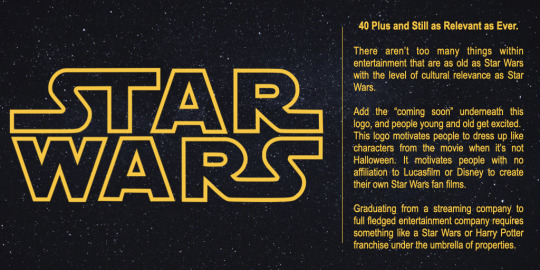
Think Long Term, Build Franchises
Star Wars is over 40 years old. The Harry Potter and The Lord of the Rings movies turned 20 last year, as did The Fast and The Furious franchise. What's on Netflix today that will be talked about or cared about in 20 years? It’s time for Netflix to focus on building franchises that fans care deeply about. It won’t be easy, but it’s not impossible. There are thousands of stories waiting to be told. And if they can’t build one, they should buy one.
Universal Studios had plans to create a Monsters Universe in 2017, think the Mummy, Jekyll and Hyde, Frankenstein, The Werewolf, and Dracula, being sent to the big screen yearly like Disney did with The Avengers. But the first movie, The Mummy (2017) with Tom Cruise and Russell Crowe didn't live up to the hype, and it appears plans for the Monster Universe have been scrapped. Are these properties for sale? The salesman in me thinks everything is for sale.
I've applauded Netflix in the past for its ability to produce content that goes viral, but what their loss of subscribers has indicated to me is that viewers feel like there is nothing to look forward to on the platform. Right now, Netflix is the king of the streaming, it is the ultimate streaming company, but Disney is the better entertainment company. It's time for Netflix to morph into an entertainment company, and it can do so by building franchises that are bigger than one week of memes and social commentary. Joe Exotic had two weeks, Mickey Mouse has had the last 94 years.
#StarWars#Streaming#Netflix#DisneyPlus#ParamountPlus#Peacock#AmazonPrime#HarryPotter#LordoftheRings#Twilight#FastandtheFurious#Marvel#Spider-Man#MickeyMouse#JoeExotic#StrangerThings#HBOMax#DCComics#Batman#Superman#Aquaman#WonderWoman
6 notes
·
View notes
Text
What Happened to WiFi
LiFi looked like a promising idea when it was introduced in 2011.
After 10 years, LiFi equipment still isn't available at your local electronics store.
What's happened to LiFi over the last 10 years?

It’s been more than a decade since the term LiFi was introduced to the world during a Ted Talks. The technology seemed like the next big thing for personal electronic manufacturers to adopt, but that hasn’t been the case. In the 10 years since the TedTalks, there have been no LiFi ready laptops or smartphones produced. Search the term LiFi at BestBuy.com ($BBY), and the website returns a LifeProof iPhone case. The same search on Amazon.com ($AMZN) returns a Kindle Book about the 100 most popular wireless networks, and a search on Walmart.com ($WMT) returns Life cereal. The technology looked so promising in 2011, so what happened to LiFi?
What is LiFi
The term LiFi was introduced to the world by Dr. Harald Haas, a German physicist of the University of Edinburgh. During his TedTalks in 2011, Dr. Haas previewed the technology he had been working on. The technology allowed the transfer of data through light.
Think of a typical home WiFi system. Now put everything that the WiFi does in a light bulb, and that’s a simple way of thinking about what LiFi is. By making small modifications to an LED bulb, when turned on, the LED bulb can pass data to a receiver, and that receiver will interpret the information and display it on a TV screen, phone screen, or computer screen.
When initially introduced by Dr. Haas, he believed that LiFi Technology could be more energy efficient than what we had in place. He also believed LiFi could lighten the load carried by WiFi, because the light spectrum is 10,000 times greater than the radio waves spectrum used by WiFi. In 2020, when the coronavirus pandemic began, and people were forced to shelter in place, the global internet infrastructure came into question. With millions of people home at the same time, and streaming video and music non stop, Netflix ($NFLX), Sony ($SONY) and a few others reduced the quality of their video streams in order to prevent internet networks from overloading. A problem that could have been avoided had LiFi infrastructure been in place.
How Does it Work
Using an LED bulb outfitted with a chip, the light turns on and off at speeds so fast that it isn't noticeable to the eye. As the light turns off and on, data is transferred and picked up by a photo detector, then the detector reads the data being transmitted from the light bulb. The TV remote is similar, in that it transfers data via light, but TV remotes use infrared light. The infrared light in a remote turns on and off repeatedly, and transfers data to the receiver inside the television. The TV remote transfers a serial data stream of ones and zeros, whereas LiFi sends a paralleled data stream of ones and zeros. The data coming from a TV remote is like the water stream coming from a water gun you would find at a 99 cents store, and the data coming from a LiFi bulb is like water shooting out of a fire-fighter’s hose.
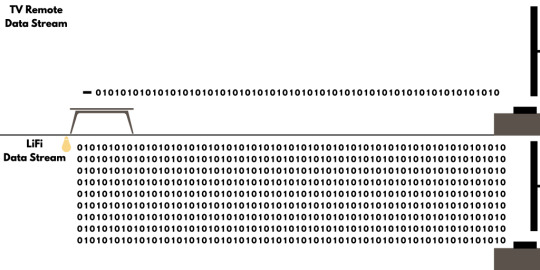
With LiFi, data can't be transferred when the light is off. This presents a problem for anyone who likes to spend a few minutes on TikTok right before going to bed. But by using light dimmers, the light can be dimmed to the point where it appears that it is off, which will allow for the flow of data in the dark.
Where Has LiFi Been Since The Ted Talks
In his 2011 Ted Talks, Dr. Haas mentioned that in order to fully exploit the light spectrum with LiFi, advanced transmitters and receivers were needed. LiFi represented a new take on data transfer, and because of that it required an infrastructure that wasn't in place in 2011. That lack of infrastructure is why we haven't seen LiFi systems in BestBuy yet. The last 10 years was also spent educating the markets about the technology, which has resulted in large companies like Samsung and Panasonic exploring LiFi enabled technology. According to LiFi.co, Samsung currently holds the most LiFi related patents.
Though the average consumer hasn’t been able to buy a LiFi setup, the technology is being implemented. In 2016, Oledcomm, a firm in Paris, won the right to outfit several Paris subways with LiFi. In 2021, pureLiFi, a company based in Scotland, was called on by the U.S. Army twice to supply it with LiFi technology. If the last 10 years was about getting the word out on LiFi, the next 10 years will hopefully be about adopting and adapting the technology to meet everyday needs.
Does the World Need Another Way to Access the Internet
Twenty five years ago, there were very few items that required internet bandwidth. For homes that were on the internet, those homes were logging on with a desktop computer, there were no smartphones or smart devices, and movie streaming didn’t exist. Today, one home could have multi devices online, from televisions and phones, to thermostats, refrigerators, and door locks. This has led to spectrum crunch, or an insufficient amount of wireless frequency spectrum needed to support the growing number of devices. The visible light spectrum is a much wider spectrum than the radio wave spectrum used by WiFi, and can help solve spectrum crunch.
There’s also a matter of security. WiFi has proven not to be the most secure way to send data. Because radio waves can travel through obstacles like walls, it allows us to gain access to the internet via a wifi connection from almost anywhere. But it also allows bad actors to gain access to the same wifi connection, whether they are inside our home or business or not. With LiFi, data can only be received by devices within the path of the light, making it a more secure way to send sensitive data.
LiFi could also prove to be more efficient than what we use today. LED bulbs have been touted for their efficiency when compared to older incandescent light bulbs. The average incandescent light bulb can last for 1,000 hours, whereas LED bulbs can last for thousands of hours before needing to be changed. Also, by using LED lights to transfer data, we could eliminate the need for devices like WiFi amplifiers, antennas, modems, routers, and all of the wiring that accompanies them.
There are some drawbacks to LiFi. Currently, LiFi only covers a diameter of 10 meters. A WiFi network has the ability to cover 32 meters. Also, because light cannot travel through walls, any home and office considering installing a LiFi system will need to have data transmitting light bulbs in every room that requires internet. This isn’t as bad as it appears, as most rooms that need internet typically need light as well, but it can be expensive. Life.co, claims its LiFiMax kit is the most affordable LiFi product on the market today, and it’s being sold for $1,098. The kit is plug and play, and includes one LiFi access point and two sensors or dongles, and also requires a separate purchase of a power over ethernet injector for $20, and the ethernet cable for $7. At that price range, a LiFi setup is out of reach for most. Outside light is also a problem for LiFi. Any light coming from sources other than the LED bulb transmitting the signal will disrupt the flow of data, this includes sun rays coming from outside the room where the LiFi access point is located.
If LiFi matures like other great technologies of the past, some of these issues should get better over time. And as the ecosystem for LiFi is developed, this should create more LiFi users, which should bring down the price of LiFi units.

Internet Access of the Future
LiFi will be in our future. After seeing Dr. Haas’ Ted Talks in 2011, I expected LiFi to take off immediately. But after several years of not seeing anything LiFi related, I thought the idea had been scrapped. Though it hasn’t taken off, I’m happy to know the idea isn’t dead, and that there are several companies working to improve LiFi and educate people on the technology. Knowing that early concepts of the internet had a start within the U.S. military, I’m taking the U.S. Army’s use of LiFi as a very positive signal for LiFi’s future.
Now that I’ve figured out what happened to LiFi, the question I have now is who will be the first company to add LiFi enabled receivers to their devices? The safe bet is Samsung, because it holds a large number of LiFi patents. But I shouldn't count Apple out. It was Apple ($AAPL), in 1999, that added wireless networking to its iBook, at a time when most people were still connecting to the internet with a home phone line, and before WiFi was the standard. Then there's Oppo, who patented a smartphone with LiFi technology
If the last 10 years was about creating awareness for LiFi, the next 10 years could be about adoption. Progress can be a slow process at times, and the full blown adoption of LiFi is moving slower than I expected, but it is moving forward, and that's great to know.
#LiFi#Li-Fi#LightFidelity#Tech#Technology#Science#TedTalks#WiFi#Internet#Apple#Samsung#Oppo#Philips#GE#Qualcomm#Panasonic
0 notes
Text
Elon's Magic Touch Too Good For Twitter
Twitter's influence can be seen and felt every day, yet the company feels under monetized.
Elon Musk has shown a magic touch when it comes to business. Can he improve Twitter's money making abilities?
Is running a social media platform the best use of Elon Musk's time?
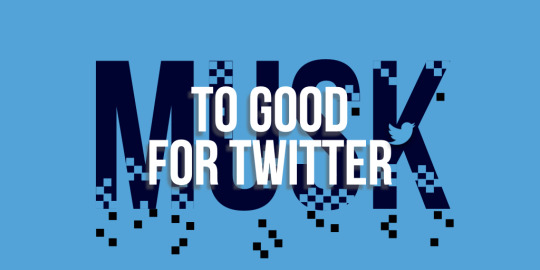
The Influence of Twitter
You’re watching CNBC, the network anchor is discussing a tweet made by one of Wall Street’s influential money managers. In the tweet, the money manager questions a publicly traded company’s ability to grow its subscriber base. The stock, which closed nearly unchanged the previous day, is down 10% in premarket trading. Next, you turn the TV to ESPN, where the anchors are analyzing a tweet made by a professional athlete regarding his contract negotiation. Before the tweet, no one had heard from the player about his contract demands, now it's the leading topic of discussion throughout sports. You then turn to your local news to find out what’s happening in your area. Your favorite local news network is displaying a tweet from the local authorities explaining a shooting and an investigation in your area. Thanks to Twitter and the news, you know to avoid the area on your way to work. You pull out your phone to see a new Twitter notification. Twitter notifies you that a celebrity who you really admire, liked one of your tweets. The notice causes you to experience something close to an orgasm.
Twitter ($TWTR) has never made the revenue to reflect how influential it is, but it is a powerful platform. I believe if Twitter’s management, whoever that is in the next few months, is ever able to financially exploit the full influence of Twitter, shareholders - assuming it’s still a public company - will mark Twitter as one of their greatest investments of all time.

The Magic Touch
Two week ago, after it was announced that Tesla ($TSLA) CEO, Elon Musk, purchased 9 percent of Twitter, I started putting thoughts down about why Twitter’s current CEO and board of directors should be terrified. Before I could get my thoughts together, Elon made his offer to purchase Twitter, which was not a surprise.
Elon’s relationship with Tesla began with him being an investor in the car company started by Martin Eberhard and Marc Tarpenning. But for as long as many people can remember, Elon has been the guy at Tesla. While most of us are working as hard as we can to realize one big win in life, Musk got his first big win in the 90’s with PayPal ($PYPL). Tesla is his follow up album, and it’s also a hit. When you add in SpaceX and The Boring company, it’s what Snoop Dog said about Drake, “That mother f_cker don’t miss.”

Musk will probably win with Twitter as well, if he’s able to acquire it. I’ve thought for the past several years that Twitter is a different animal, but that it’s not being monetized to its fullest potential. But I admit, that I have no idea how to better monetize the platform. I’m sure Elon will figure out a way to do it. But is that the best use of his time? I think Elon running Twitter is a terrible waste of a brilliant mind.
A Chance to Make Another Big Impact
Over the last few years, I’ve been listening to the life stories of people who had suffered life changing spinal cord injuries. Some people's injuries were caused by a very freak accident, while others, unfortunately, ended up injured after being in the wrong place, at the wrong time. No matter how the injury occurred, I always feel something when the story gets to the day everything changed. Most of the interviews I’ve listened to are from adults, who have lived with their injury for a decade or more. And many of them don’t prioritize walking over living the best life they can now, but some of them have admitted to keeping an eye on what Elon is working on with Neuralink. One of Neuralink's goals is to help people with paralysis regain their independence. When I heard about the Twitter bid, I instantly thought about Neuralink. Of the many projects Musk is working on, Neuralink is the one that I root for the most.
SpaceX is another Musk project I actively root for. I would love to see Musk get mankind to Mars while I’m still alive. I’ll admit that several years ago, I thought Elon Musk was out of his mind with the talk of going to Mars. But I’ve come around, and I consider myself a Space X cheerleader now.
What I’d hate to see happen is Neuralink stall or Space X’s advancements slow down, because Elon Musk has to spend time testifying to congress, to explain why shitty people are saying and doing shitty things on Twitter. This Twitter thread by @yishan does a great job of explaining why running a social network is difficult. Does Elon Musk really want the headache of running Twitter?

Twitter isn’t perfect, it’s actually very ugly most times, but that’s not Twitter's fault, that’s society, and there’s no fixing society. But I love Twitter. I love that it’s customizable. We decide who we want to hear from, and we determine what news or entertainment makes it on our feed. I love that Twitter is part broadcast system and part personal communication tool. You can broadcast that you've done something special, and then communicate with someone one-on-one to discuss the special thing you did. I love that Twitter cuts out middlemen. Fans of Elon Musk don’t have to wait for a NY Times piece to find out what Elon is up to, the easiest way to find out what Elon Musk is doing, or thinking, is by following him on Twitter. I love that Twitter is in real time. If something is happening in the world, someone is tweeting about it. Twitter can be a toxic place at times, but it does have some great qualities.
Elon is highly intelligent, highly motivated, and an ultimate winner in business. If there’s anyone who can figure out how to maximize Twitter's revenue, it’s Elon Musk. But I’m hoping he loses the battle for Twitter. I think there are better companies, with better ideas that can benefit from Elon's magic touch.
#ElonMusk#Musk#Tesla#Neuralink#PayPal#SpaceX#BoringCompany#Money#Investments#Investing#FinancialEducation#InvestmentEducation#Twitter#TwitterTakeOver#TwitterAcquisition#FundingSecured#HostileTakeover#Poison pill#SocialMedia
0 notes
Text
Is Robinhood Getting into DeFi?
Robinhood has added several new cryptocurrencies to their list of investable crypto assets.
Of the new cryptocurrencies added, three are associated with decentralized finance.
Over $200 billion is locked into DeFi protocols, yet the industry remains unregulated.
A mix of regulation, centralization, and DeFi could bring new investors to Robinhood.
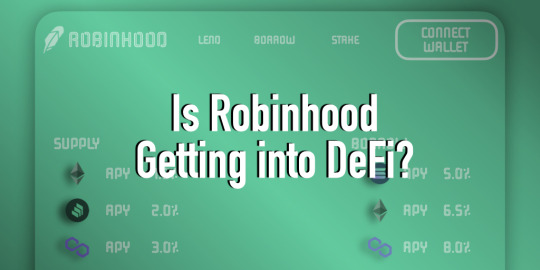
Last week Robinhood added to the list of cryptocurrencies that can be bought and sold on the Robinhood ($HOOD) investing platform. Compound ($COMP1-USD), Solana ($SOL-USD), Polygon ($MATIC-USD), and Shiba Inu ($SHIB-USD) were added by Robinhood, and brings the amount of tradable crypto assets on Robinhood to 11.
What was notable about the four digital currencies selected by Robinhood is that three of the cryptocurrencies have utility within decentralized finance, and one is a meme token, or a coin without utility. Robinhood’s selection could be a sign of where the company wants to go in the future, while positioning itself to take advantage of the next meme stock / meme token rally.
Meme Stock Mania
Robinhood was at the center of the meme stock trade in 2021, where investors bought into stocks of struggling companies that had large short positions. The immense buying by Robinhood traders and others, caused stock prices in companies like GameStop ($GME) and AMC ($AMC) to increase rapidly, forcing short sellers - those that profit when stock prices decline - to purchase the stock to cover their shorts and cut their losses. The heavy buying by the investors who were short added to the stock price’s increase. The meme stock investment frenzy also had an impact on Dogecoin ($DOGE-USD), a crypto currency with no utility at the time. Dogecoin entered 2021 trading for less than a penny per coin. The meme stock / meme coin investment trend would push DOGE to 73 cents, an all time high, and a more than 12,000% increase from where it started the year.

Source: Yahoo Finance
The meme trade was good to Robinhood. In the first three months of 2021, the company’s revenue grew to $522 million, marking a 309% increase from the same quarter a year before.
Dogecoin’s increase in price in 2021, put a spotlight on Shiba Inu, another meme coin, which was billed as the Dogecoin killer. Shiba Inu’s popularity grew in 2021, and believers in the coin pushed hard for Robinhood to add it to the trading platform. A Change.org petition, calling for Robinhood to add Shiba Inu, secured over 500,000 signatures.
During the meme stock trend of 2021, investing in Shiba Inu was difficult for investing newbies, especially those without any knowledge of decentralized exchanges. To buy the Shiba Inu token last year required several steps, such as obtaining a crypto wallet like MetaMask, funding the wallet, then finding a decentralized exchange that offered Shiba Inu for purchase. In addition, there were hefty gas fees (processing fees charged for transactions on the Ethereum network). Even Coinbase, the popular centralized cryptocurrency exchange didn’t offer Shiba Inu tokens during early 2021.
Unlike Shiba Inu, Compound, Solana, and Polygon were created with the intention of being useful. The Compound token, created by Compound Finance, is offered as a form of interest to crypto investors that stake their crypto assets on the Compound Finance platform. Solana, labeled by its fans as the Ethereum killer, operates on its own blockchain, and can execute over 60,000 transactions a second, in comparison, Ethereum can only execute 30 transactions per second. Polygon was created with the aim of lowering fees for transactions on the Ethereum blockchain. The utility of these tokens have made them relevant building blocks in the construction of decentralized finance.
What is DeFi
Decentralized Finance or DeFi, has taken aspects of traditional finance like lending, borrowing, investing, and insurance and put them on the blockchain. DeFi sites like Compound allow users to virtually lodge their crypto assets and earn interest on those assets, without having to fill out an application or sign a document. The same goes for borrowing, with a few clicks to connect a crypto wallet to the Compound site, a user can borrow money from Compound by using their crypto assets as a collateral.
Polygon’s network has provided thousands of DeFi startups a blockchain that runs parallel to Ethereum to deploy their apps on. Many of the current DeFi protocols have been built on the Ethereum network, which has caused a lot of traffic on the network, and has resulted in high gas fees for transactions. For instance, staking $50 of Ethereum on the Compound Finance site, which was built on the Ethereum blockchain, can cost $30 in additional fees. Using the Polygon network, fees for asset transfers amount to a few pennies. Solano provides another blockchain to conduct financial transactions on, also at a cheaper rate than Ethereum. Similar to how Compound Finance operates as a bank on the Ethereum network, Aave provides a similar service on several blockchains, one being Polygon. Apricot is a lending and borrowing protocol created on the Solana blockchain.

Robinhood Goes DeFi
DeFi is both exciting and speculative. DeFi platforms in their startup stage typically offer annual percentage yields that are sometimes 10x more or higher than what traditional banks offer, which is exciting for people who have a digital wallet filled with crypto whose prices aren’t moving up. Because DeFi platforms are unregulated, crypto investors take a big risk when they lock their crypto assets to a platform, and users have no recourse if a platform goes bust.
a relatively new scam type particularly common in DeFi, in which the developers of a cryptocurrency project — typically a new token — abandon it unexpectedly, taking users’ funds with them. - https://blog.chainalysis.com
DeFi sites like Compound, Aave, Curve.Fi, and Maker are a few of the well known DeFi apps providing crypto enthusiasts conservative options to make money on their crypto holdings, but there are bad actors in the space. Some sites have offered extremely high interest rates in order to draw crypto investors to their apps, only to renege on their offer and leave investors holding a bag of worthless coins (see the explanation of a rug pull above).
Companies like Coinbase and Crypto.com are centralized and regulated, but are offering DeFi features to their users. With the addition of Solana, Compound, and Polygon to Robinhood, in addition to the crypto wallet feature that Robinhood recently rolled out, some level of DeFi offering could be in the works at Robinhood. A developer recently discovered code to a beta version of a stock loan program, which would allow Robinhood users to loan out stock to other institutions who require the stock to settle trades or conduct short sales. A similar feature could be applied to cryptocurrencies, and allow crypto investors on Robinhood to stake their crypto currency in return for interest.
Though not in the same category as Compound, Polygon or Solana, the creators of Shiba Inu and the Shiba Inu community are creating an ecosystem around the token. Shibaswap is one project that was created in support of the Shiba Inu token. AMC recently announced that it would accept Shiba Inu, as well as Dogecoin as payment.
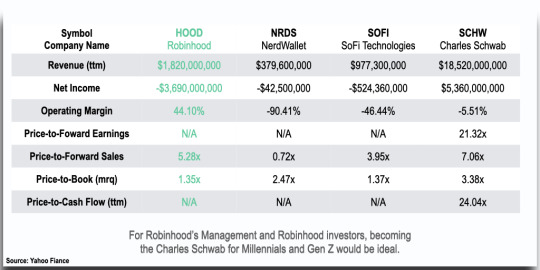
Robinhood’s Stock
Robinhood’s stock ended last week’s trading at $11.38 per share. The company went public last July at $38 per share, and traded to a high of $85 per share shortly after the initial public offering. Since trading to $85, the stock has been in decline. The all-time low for the stock is $9.93, which the stock traded down to in February. According to Tipranks, the price target for Robinhood is $17.00 per share. The target is based on 12 analysts who have offered price targets on Robinhood over the last three months. The highest forecast among the analysts is $41, with the lowest price target being $11.00.
According to DeFiLlama there is over $200 billion spread out among several hundred DeFi protocols. A DeFi offering could help Robinhood attract people to the trading app who are interested in DeFi, but are turned off by the unregulated aspect of it, as well as people who find the process of getting started in DeFi too difficult.

#DeFi#DecentralizedFinance#decentralized finance#DeFi Pulse#DeFiLlama#Aave#Compound#Polygon#Matic coin#Solana#blockchain#StockMarket#Robinhood#$HOOD#Cryptocurrency#CryptoWallet#InvestmentEducation#FinancialEducation#Bitcoin#Ethereum#Dogecoin#Shiba Inu#Coinbase
0 notes